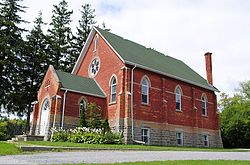Locust Hill, Ontario
Locust Hill | |
|---|---|
Unincorporated community and former hamlet | |
 Locust Hill United Church | |
| Coordinates: 43°53′16″N 79°11′52″W / 43.88778°N 79.19778°W | |
| Country | Canada |
| Province | Ontario |
| Regional municipality | York |
| City | Markham |
| Established | 1832 |
| Elevation | 205 m (673 ft) |
| Time zone | UTC-5 (EST) |
| • Summer (DST) | UTC-4 (EDT) |
| Area code(s) | 905 and 289 |
Locust Hill is a historic community of Markham, Ontario centred on Hwy. 7 and the Canadian Pacific Railway and within the boundaries of the future national Rouge Park.
History

Locust Hill was first settled about 1799 by Samuel Reynolds, a United Empire Loyalist from Dutchess County, New York. The hamlet, centred on lots 10 and 11, concession 10. Today the area is made up of existing and newer homes along Highway 7.
Locust Hill only became a place of significance with the arrival of the Ontario and Quebec Railway in the 1884, linking Toronto with Peterborough. Area business leaders from Whitevale and Green River petitioned to create a railway station at Locust Hill. The hamlet and station were named after the farm of William and Esther Reesor Armstrong, where locust trees were a prominent feature.[1]
Locust Hill was one of the busiest stations on the Toronto-Perth line and was built on the St Clair Farm owned by Captain William Button on the northwestside of Highway 7.[2] Flour, brushes, livestock and milk were shipped out of Locust Hill in quantity. In 1887 an elevator and mill were built east of the station, a water tower on the west side,[3] and a co-operative creamery was built on the south side of Highway 7 on the east bank of the Rouge River in 1893 (it burned down in 1910[4]). The original Van Horne style[5] one and half storey station burned down in 1935 and was replaced by a single floor station in 1936. Rail service through Locust Hill ceased in 1969, but the line is still active. The old Locust Hill Station has been relocated in 1983[6] and reconstructed at the Markham Museum and Historic Village and the station platform was removed and replaced with a grass strip.
Retail Sections
Locust Hill had a general store (located on southwest side of railway tracks along Highway 7 and was torn down and now a vacant lot), blacksmith shop.
Churches, post office and school
In 1856, a Methodist Church as well[7]
A brick schoolhouse, SS#21, was built in 1864 on east side of Reesor Road north of Highway 7 and remained in use to the 1960s, converted to residential used and now partially repaired to the original configuration by Toronto Region Conservation Authority in 2017.[8]
A post office on Highway 7 was opened in 1886 and remains in use today.
The present church structure, Locust Hill United Church, was built in 1890[9] is shared site with Eastside Baptist Church. A cemetery is located across Highway 7 from the church and a cairn was added in the cemetery in 1990.
Future: Rouge National Park
While much of the city of Markham has become residential, the land immediately around Locust Hill is still in agricultural use. In 2011 the Canadian federal government announced plans to create a national Rouge Park. The park will completely encompass the community of Locust Hill.[10]
Transportation
The main transportation link in Locust Hill is Highway 7 and Highway 407.
Locust Hill Line
Metrolinx has a planned spur line off from the purposed Midtown corridor terminating a Locust Hill.
In film
- The 1974 film, Vengeance is Mine, starring Ernest Borgnine was filmed partially at the Locust Hill train station (which now sits on the Markham Museum grounds).
- The 1976 film, Silver Streak, starring Richard Pryor includes a train scene in the hamlet where the general store can be seen.
References
- ^ For a full account of Locust Hill's history, cf. Isabel Champion, ed., Markham: 1793-1900 (Markham, ON: Markham Historical Society, 1979), pp. 246-248; 160; 183ff.; 89. See also Myra Chepack, "Markham Fair President 1910: James McCreight Armstrong[permanent dead link]," Markham Fair official website. Esther Reesor Armstrong was a daughter of Peter Reesor, founder of Reesorville, later the Village of Markham.
- ^ "Archived copy". Archived from the original on 2016-04-10. Retrieved 2016-03-24.
{{cite web}}: CS1 maint: archived copy as title (link) - ^ http://www.trainweb.org/oldtimetrains/CPR_Trenton/stns/locusthill.htm
- ^ "Archived copy". Archived from the original on 2016-04-10. Retrieved 2016-03-24.
{{cite web}}: CS1 maint: archived copy as title (link) - ^ Brown, Ron (2014-08-19). The Train Doesn't Stop Here Anymore: An Illustrated History of Railway Stations in Canada. ISBN 9781459727830.
- ^ http://www.trainweb.org/oldtimetrains/CPR_Trenton/stns/locusthill.htm
- ^ See the detailed 1878 map, "Township of Markham," Illustrated historical atlas of the county of York and the township of West Gwillimbury & town of Bradford in the county of Simcoe, Ont. (Toronto: Miles & Co., 1878). Note that Locust Hill is not noted, only Belford.
- ^ https://canada.constructconnect.com/dcn/news/projects/2017/07/old-school-masonry-work-stabilizes-locust-hill-school-house-1026000w
- ^ See North Pickering Community Development Project, The Historical Complexities of Pickering, Markham, Scarborough and Uxbridge Archived 2011-09-28 at the Wayback Machine, Sept. 1973, pp. 52f.
- ^ See the Rouge Park Alliance, Park Map Archived 2011-07-23 at the Wayback Machine.
